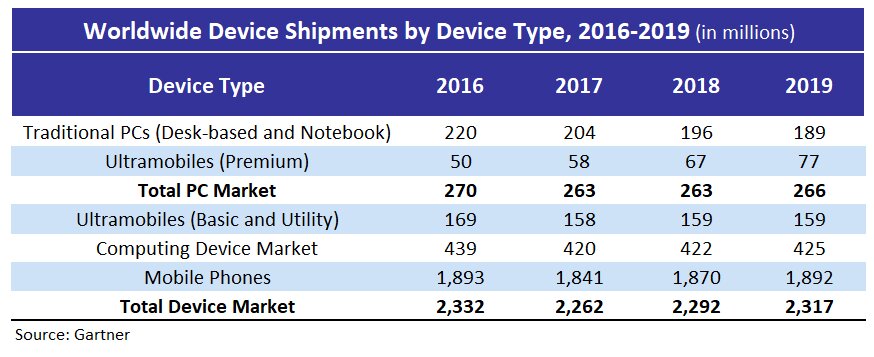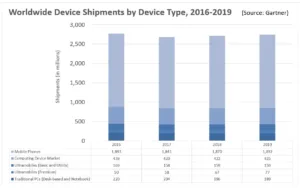After a decline of 3% in 2017, worldwide shipments of devices are forecast to grow 1.3% in 2018 and will total 2.3 billion units, according to Gartner. While device shipments fluctuate year-on-year, end-user device spending continues to rise and is forecast to increase 7% in 2018. Gartner research director Ranjit Atwal said:
“Driven by better specifications despite increasing costs ASPs for devices rose by 9.1% in 2017, and this trend will continue through this year, where we expect prices will increase by 5.6%”.
Despite PC prices increasing 4.6% in 2018, PC market unit demand, driven by business buying, is stabilising through 2018. The traditional PC market will decline 3.9% in units in 2018 and is expected to decline a further 3.6% during 2019.

Economic upheaval has affected demand for devices variably across regions. Argentina, Brazil, Japan and Russia collectively lost nearly 25% of their device shipments between 2013 and 2017. In countries suffering from significant economic turmoil, the extended lifetimes across all device types tend to remain stagnant. Atwal continued:
“While the rate of recovery is varied regionally, most of the device types are now showing growth across these countries. As markets recover, they will fail to reach the unit volumes previously seen and will only recover to around 70% of those shipments by 2022”.
Gartner forecasts that global mobile phone shipments will increase 1.6% in 2018, with total mobile phone sales amounting to almost 1.9 billion units. In 2019, smartphone sales are on pace to continue to grow, at 5% year-on-year. Overall, Gartner estimates that mobile phone lifetimes will increase from 2017 through 2020. Mobile phone lifetimes will start to reduce again beyond 2020, while future AI capabilities, including natural-language processing and machine perception will allow smartphones to learn, plan and solve problems for users. Gartner research director Anshul Gupta also said:
“Premium phone lifetimes are expected to increase the most in the near-term, as users look to hold onto these devices due to a lack of new technology impact, prohibiting upgrades.
By 2020, AI capabilities in smartphones will offer a more intelligent digital persona on the device. Machine learning, biometrics and user behavior will improve ease of use, self-service and frictionless authentication. This will allow smartphones to be more trusted than other credentials, such as credit cards, passports, IDs or keys.
This is not just about making the smartphone smarter, but augmenting users by reducing their cognitive load and enabling a ‘digital me’ that sits on the device”.
Analyst Comment
If these forecasts turn out to be accurate, the level of growth is in the margin of error for all the categories except for ‘premium ultramobiles’, which should see solid growth.

